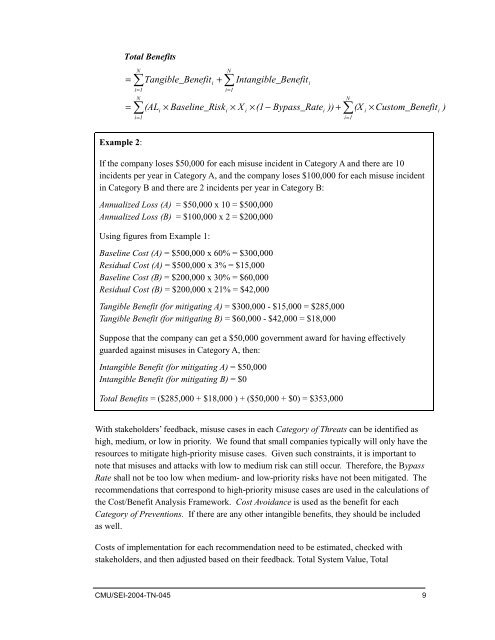SQUARE Project: Cost/Benefit Analysis Framework for Information ...
SQUARE Project: Cost/Benefit Analysis Framework for Information ...
SQUARE Project: Cost/Benefit Analysis Framework for Information ...
Create successful ePaper yourself
Turn your PDF publications into a flip-book with our unique Google optimized e-Paper software.
Total <strong>Benefit</strong>s<br />
=<br />
=<br />
N<br />
∑<br />
i=<br />
1<br />
N<br />
∑<br />
i=<br />
1<br />
Tangible_B enefit<br />
i<br />
+<br />
N<br />
∑<br />
i=<br />
1<br />
(AL × Baseline_Risk × X<br />
i<br />
i<br />
Intangible_<strong>Benefit</strong><br />
i<br />
× (1 − Bypass_Rate )) +<br />
i<br />
i<br />
N<br />
∑<br />
i=<br />
1<br />
(X<br />
i<br />
× Custom_<strong>Benefit</strong><br />
i<br />
)<br />
Example 2:<br />
If the company loses $50,000 <strong>for</strong> each misuse incident in Category A and there are 10<br />
incidents per year in Category A, and the company loses $100,000 <strong>for</strong> each misuse incident<br />
in Category B and there are 2 incidents per year in Category B:<br />
Annualized Loss (A) = $50,000 x 10 = $500,000<br />
Annualized Loss (B) = $100,000 x 2 = $200,000<br />
Using figures from Example 1:<br />
Baseline <strong>Cost</strong> (A) = $500,000 x 60% = $300,000<br />
Residual <strong>Cost</strong> (A) = $500,000 x 3% = $15,000<br />
Baseline <strong>Cost</strong> (B) = $200,000 x 30% = $60,000<br />
Residual <strong>Cost</strong> (B) = $200,000 x 21% = $42,000<br />
Tangible <strong>Benefit</strong> (<strong>for</strong> mitigating A) = $300,000 - $15,000 = $285,000<br />
Tangible <strong>Benefit</strong> (<strong>for</strong> mitigating B) = $60,000 - $42,000 = $18,000<br />
Suppose that the company can get a $50,000 government award <strong>for</strong> having effectively<br />
guarded against misuses in Category A, then:<br />
Intangible <strong>Benefit</strong> (<strong>for</strong> mitigating A) = $50,000<br />
Intangible <strong>Benefit</strong> (<strong>for</strong> mitigating B) = $0<br />
Total <strong>Benefit</strong>s = ($285,000 + $18,000 ) + ($50,000 + $0) = $353,000<br />
With stakeholders’ feedback, misuse cases in each Category of Threats can be identified as<br />
high, medium, or low in priority. We found that small companies typically will only have the<br />
resources to mitigate high-priority misuse cases. Given such constraints, it is important to<br />
note that misuses and attacks with low to medium risk can still occur. There<strong>for</strong>e, the Bypass<br />
Rate shall not be too low when medium- and low-priority risks have not been mitigated. The<br />
recommendations that correspond to high-priority misuse cases are used in the calculations of<br />
the <strong>Cost</strong>/<strong>Benefit</strong> <strong>Analysis</strong> <strong>Framework</strong>. <strong>Cost</strong> Avoidance is used as the benefit <strong>for</strong> each<br />
Category of Preventions. If there are any other intangible benefits, they should be included<br />
as well.<br />
<strong>Cost</strong>s of implementation <strong>for</strong> each recommendation need to be estimated, checked with<br />
stakeholders, and then adjusted based on their feedback. Total System Value, Total<br />
CMU/SEI-2004-TN-045 9
















